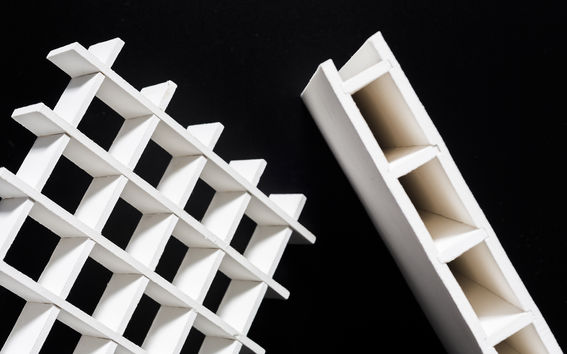Kerrostettu selluloosa: Kierrätettävät biomateriaalirakenteet

Milloin
Missä
Tutkimus tehtiin yhteistyössä VTT:n kanssa ja sen rahoitti Business Finland.
***
Construction industry consumes a lot of materials, which also often are not biodegradable, bio-based or recyclable. Materials used in furniture, interiors and construction consist of several ingredients which might be difficult to separate and recycle, and some of them can be harmful for human or nature.
This exhibition shows prototypes which study nanocellulose as a glue and an ingredient for strong all-cellulose material for structural purposes. The goal was to make an environmentally friendly all-cellulose material by using it as an adhesive to glue together sheets of paper. The samples were laminated together by pressing to achieving strong board-like material. All-cellulose material can be patterned, painted or printed, but also worked with conventional wood working tools such a circular saw.
All-cellulose material is bio-based, bio-degradable and contain no other ingredients than wood-based materials, and thus it is recyclable among newspaper waste at the end of the life-cycle. No harmful chemicals are needed as binding materials. The strength of the all-cellulose material is equal with many boards. Early material tests proved that bending strength was better than with chip board, gypsum board, softwood plywood and MDF board.
Material is literally blank as a paper; new forms, shapes, visuality or usages can be further developed. It could be used to replace environmentally harmful boards, laminates or vertical structures, like door structures or structures in general, furniture and interior applications.
More research will be needed to better understand material properties, improve production possibilities and water tolerance of the gluing material.
The research was done in collaboration with Aalto University and VTT Technical Research Centre of Finland Ltd. during multidisciplinary project Design Driven Value Chains in the World of Cellulose 2.0 funded by Business Finland.
The team:
-
Heidi Turunen, Department of Architecture, Aalto University
-
Vesa Kunnari, Timo Kaljunen, Jaakko Pere, VTT Technical Research Centre of Finland Ltd.
Contact:
Heidi Turunen, heidi.turunen@aalto.fi
Vesa Kunnari vesa.kunnari@vtt.fi, Kirsi Kataja kirsi.kataja@vtt.fi
Ympäristöt eläviksi
Aggressiivinen kaupungistuminen rasittaa ekosysteemiamme. Kasvava rakentaminen johtaa valtavaan energiaintensiivisten rakennusmateriaalien kysyntään, ja rakentamisen osuus muodostaa jo 39 prosenttia maailman hiilidioksidipäästöistä.







